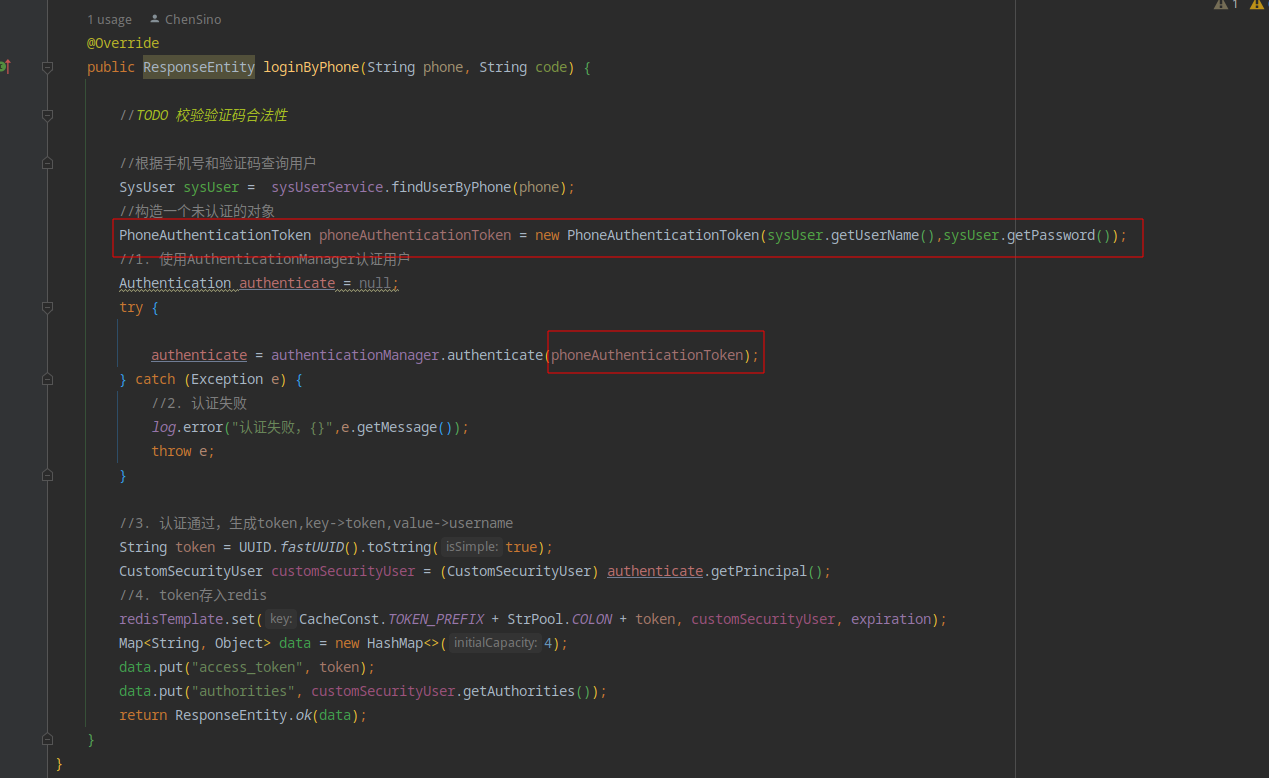Security扩展自定义登录方式
大约 4 分钟
1、需求
前后分离项目使用不同登录方式进行登录
1. 使用帐号/密码登录
2. 使用手机号/验证码登录
2、实现方法
注
Security是一个扩展性很强的框架,预留了各种端点进行扩展,多种方式登录需要扩展AuthenticationProvider,进行自定义实现。默认情况 Security使用的是DAOAuthenticationProvider,就是从数据库中读取用户名/密码进行校验。
2.1 自定义AuthenticationProvider
思考
自定义了AuthenticationProvider后为什么连AuthenticationToken也要自定义?
为什么不直接用UsernamePasswordAuthenticationToken?
//自定义AuthenticationProvider
@Component
@Slf4j
public class CustomMobileAuthenticationProvider implements AuthenticationProvider {
@Autowired
private UserDetailsService userDetailsService;
@Override
public Authentication authenticate(Authentication authentication) throws AuthenticationException {
log.info("enter into custom AuthenticationProvider");
//
CustomSecurityUser customSecurityUser = (CustomSecurityUser) userDetailsService.loadUserByUsername(authentication.getPrincipal().toString());
PhoneAuthenticationToken phoneAuthenticationToken = new PhoneAuthenticationToken(customSecurityUser,null);
return phoneAuthenticationToken;
}
@Override
public boolean supports(Class<?> authentication) {
return PhoneAuthenticationToken.class.isAssignableFrom(authentication);
}
}
2.2 自定义AuthenticationToken
//自定义AuthenticationToken
public class PhoneAuthenticationToken extends AbstractAuthenticationToken {
private static final long serialVersionUID = SpringSecurityCoreVersion.SERIAL_VERSION_UID;
private final Object principal;
private Object credentials;
/**
* This constructor can be safely used by any code that wishes to create a
* <code>UsernamePasswordAuthenticationToken</code>, as the {@link #isAuthenticated()}
* will return <code>false</code>.
*
*/
public PhoneAuthenticationToken(Object principal, Object credentials) {
super(null);
this.principal = principal;
this.credentials = credentials;
setAuthenticated(false);
}
/**
* This constructor should only be used by <code>AuthenticationManager</code> or
* <code>AuthenticationProvider</code> implementations that are satisfied with
* producing a trusted (i.e. {@link #isAuthenticated()} = <code>true</code>)
* authentication token.
* @param principal
* @param credentials
* @param authorities
*/
public PhoneAuthenticationToken(Object principal, Object credentials,
Collection<? extends GrantedAuthority> authorities) {
super(authorities);
this.principal = principal;
this.credentials = credentials;
super.setAuthenticated(true); // must use super, as we override
}
/**
* This factory method can be safely used by any code that wishes to create a
* unauthenticated <code>UsernamePasswordAuthenticationToken</code>.
* @param principal
* @param credentials
* @return UsernamePasswordAuthenticationToken with false isAuthenticated() result
*
* @since 5.7
*/
public static UsernamePasswordAuthenticationToken unauthenticated(Object principal, Object credentials) {
return new UsernamePasswordAuthenticationToken(principal, credentials);
}
/**
* This factory method can be safely used by any code that wishes to create a
* authenticated <code>UsernamePasswordAuthenticationToken</code>.
* @param principal
* @param credentials
* @return UsernamePasswordAuthenticationToken with true isAuthenticated() result
*
* @since 5.7
*/
public static UsernamePasswordAuthenticationToken authenticated(Object principal, Object credentials,
Collection<? extends GrantedAuthority> authorities) {
return new UsernamePasswordAuthenticationToken(principal, credentials, authorities);
}
@Override
public Object getCredentials() {
return this.credentials;
}
@Override
public Object getPrincipal() {
return this.principal;
}
@Override
public void setAuthenticated(boolean isAuthenticated) throws IllegalArgumentException {
Assert.isTrue(!isAuthenticated,
"Cannot set this token to trusted - use constructor which takes a GrantedAuthority list instead");
super.setAuthenticated(false);
}
@Override
public void eraseCredentials() {
super.eraseCredentials();
this.credentials = null;
}
}
回答上面的问题,AuthenticationProvider接口中中有个boolean supports(Class<?> authentication);方法,
此方法表明该AuthenticationProvider的处理范围,我们知道AuthenticationManager的实现类一般用的是ProviderManager,
在此类中管理了很多AuthenticationProvider负责真正的认证工作,那么当有多个AuthenticationProvider的时候,它们
是如何确定某个AuthenticationProvider是否需要对此次登录进行认证呢?玄机就在上面的support方法,一般情况下它的实现如下
@Override
public boolean supports(Class<?> authentication) {
//authentication是PhoneAuthenticationToken或其子类
return PhoneAuthenticationToken.class.isAssignableFrom(authentication);
}
上面参数authentication,是在认证时传递过来的,在Service层授权是传递的如下图所示,当认证时传递的PhoneAuthenticationToken类型,
则此类型经过supports方法判断时该Provider是否要处理此时认证,当然上面的只是一般写法,可以根据业务需求写一些复杂的判断。

2.3 自定义登录接口
//Controller层
@PostMapping("phone")
public ResponseEntity login(String phone,String code){
return loginService.loginByPhone(phone,code);
}
//Service层
@Override
public ResponseEntity loginByPhone(String phone, String code) {
//TODO 校验验证码合法性
//根据手机号和验证码查询用户,手机号——>用户
SysUser sysUser = sysUserService.findUserByPhone(phone);
//构造一个未认证的对象
PhoneAuthenticationToken phoneAuthenticationToken = new PhoneAuthenticationToken(sysUser.getUserName(),sysUser.getPassword());
//1. 使用AuthenticationManager认证用户
Authentication authenticate = null;
try {
authenticate = authenticationManager.authenticate(phoneAuthenticationToken);
} catch (Exception e) {
//2. 认证失败
log.error("认证失败,{}",e.getMessage());
throw e;
}
//3. 认证通过,生成token,key->token,value->username
String token = UUID.fastUUID().toString(true);
CustomSecurityUser customSecurityUser = (CustomSecurityUser) authenticate.getPrincipal();
//4. token存入redis
redisTemplate.set(CacheConst.TOKEN_PREFIX + StrPool.COLON + token, customSecurityUser, expiration);
Map<String, Object> data = new HashMap<>(4);
data.put("access_token", token);
data.put("authorities", customSecurityUser.getAuthorities());
return ResponseEntity.ok(data);
}
2.4 配置自定义的AuthenticationProvider
注意要记得保留默认的登录方法,当设置了自定义AuthenticationProvider时,Security不会自动注入原来默认
的DAOAuthenticationProvider了,如果想保留的话,需要我们手动注入,
/**
* 新版本security获取AuthenticationManager的两种方法
* @param authenticationConfiguration
* @return
* @throws Exception
*/
// @Bean
// public AuthenticationManager authenticationManager(AuthenticationConfiguration authenticationConfiguration) throws Exception {
// return authenticationConfiguration.getAuthenticationManager();
// }
@Bean
public AuthenticationManager authManager(HttpSecurity http) throws Exception {
AuthenticationManagerBuilder authenticationManagerBuilder =
http.getSharedObject(AuthenticationManagerBuilder.class);
authenticationManagerBuilder.authenticationProvider(customMobileAuthenticationProvider);//自定义的
authenticationManagerBuilder.authenticationProvider(authProvider());//原来默认的
return authenticationManagerBuilder.build();
}
/**
* 默认AuthenticationProvider,如果创建了自定义AuthenticationProvider,则默认的就不会被注入到AuthenticationManager,
* 所以如果还想保留默认的,需要手动创建bean,并在AuthenticationManager中注入
* @return
*/
@Bean
public DaoAuthenticationProvider authProvider() {
DaoAuthenticationProvider authenticationProvider = new DaoAuthenticationProvider();
authenticationProvider.setPasswordEncoder(passwordEncoder());
authenticationProvider.setUserDetailsService(userDetailsService);
return authenticationProvider;
}
